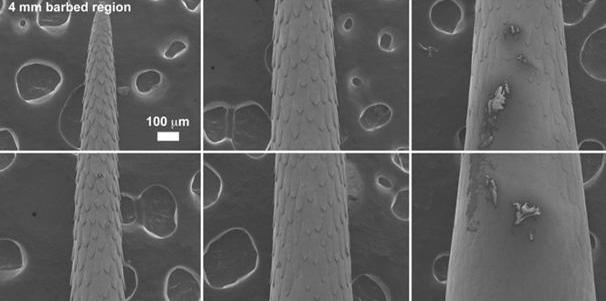This article presents the work of three research institutes (National Academy of Sciences, Seoul National University and UC Santa Barbara) that were presented in 2012. We will explore their collected knowledge without alluding to their presupposed uses. In this way, it is easier to imagine the potential technologies to your own application(s). Contact information is provided should anyone wish to start the New Year off with a bang and approach the researchers with a potential collaboration.
The Microstructure of North American Porcupine Quills
 Google “porcupine attack” and check out the images – especially that poor pooch with over 1300 quills sticking out of its face and neck! Yep, that’s gotta’ be good for something! At least a team from the National Academy of Sciences thought so.
Google “porcupine attack” and check out the images – especially that poor pooch with over 1300 quills sticking out of its face and neck! Yep, that’s gotta’ be good for something! At least a team from the National Academy of Sciences thought so.
What they found was that the micro-barbs on porcupine quills accomplish two major functions (in Biomimcry speak –> Muli-Functional Design). One, the barbs obviously are pretty darned hard to pull out (high tissue adhesion). The team found that the prevent removal of the quill to the point that flesh is stuck in the barbs when the quill is removed. Two, the unexpected result is that the barb geometry also allows easier penetration of the quill. Apparently the barbs located in the region of the quill where the quill diameter increases rapidly create localized stresses in the tissue being entered. These stress concentrations allow the barbs to more readily cut the tissue and thus reducing penetration forces. For more information refer PNAS magazine December 26, 2012 vol. 109 no. 52, or to the web page, for more information or to contact the authors.
On the (Beetle’s) Wings of Inspiration
Kahp-Yang Suh and his team from the Seoul National University noticed how the microhair on beetles’ wings and body interlock. It is exceedingly easy to lift the wings straight off the body when it is time to fly. Conversely, when the wings are down for terrestrial transport the microhairs keep them from moving laterally by creating a large shear force. I can think of hundreds of uses for that technology alone. They went one large step further.
The University team looked at the interwoven structure of the hairs and saw a strain gauge! They have developed a strain gauge that can robustly provide repeatable data for up to 10k cycles. The sensors are flexible (like skin) and can detect pressures, shears or torsion small enough to detect a bug walking, the impact of a water droplet or a heartbeat. For more information read Nature Materials 11, pages 795–801 (2012) or the web page, which has detailed information available as well as videos that go along with the Supplementary Information. There is also a contact form there allowing you to correspond with Kahp-Yang Suh.
Sensitivity is Important to Being Dynamic
A group in the chemistry department at UCSB, headed up by Kevin Plaxco, realized that the main issue with biosensors is their precision. Generally speaking, high precision requires a narrow dynamic range of what is being sensed. Unfortunately, typical biological molecule binding events require the monitoring of a much larger range than most sensors can handle.
Nature optimizes by utilizing sensing molecules that respond to both a wide and fine range of target concentrations; this is accomplished by using an array of receptors that react differently to (have differing affinities to) their common target/concentrations. These sensor arrays can be designed to accurately monitor large dynamic ranges and even have non-reactivity to a certain range (or ranges) inside the target window. This allows you to either sense everything within a particular range or sense everything outside of a particular range (only notifying you when you are above or below your required target range). For more information, see the UCSB web page or contact Andrea Estrada at UCSB at 805-893-4620.
Happy New Year and best of luck with all of your design opportunities in 2013!
References:
- Microstructured barbs on the North American porcupine quill enable easy tissue penetration and difficult removal, Woo Kyung Cho, James A. Ankrum, Dagang Guo, Shawn A. Chester, Seung Yun Yang, Anurag Kashyap, Georgina A. Campbell, Robert J. Wood, Ram K. Rijal, Rohit Karnik, Robert Langer, and Jeffrey M. Karp; PNAS December 26, 2012 vol. 109 no. 52 21289-21294.
- A flexible and highly sensitive strain-gauge sensor using reversible interlocking of nanofibres, Changhyun Pang, Gil-Yong Lee, Tae-il Kim, Sang Moon Kim, Hong Nam Kim, Sung-Hoon Ahn & Kahp-Yang Suh, Nature Materials, Nature Materials 11, 795–801 (2012).
- Chemists Mimic Nature to Design Better Medical Tests, UC Santa Barabara.








